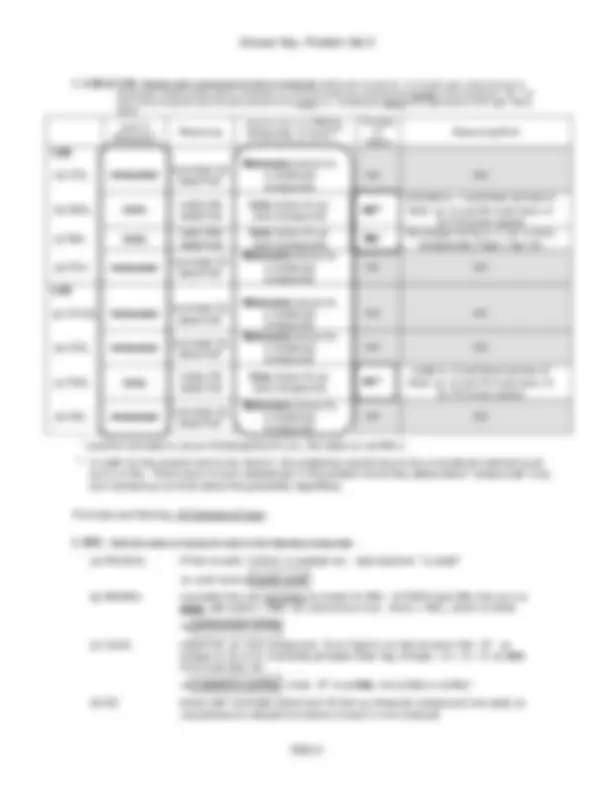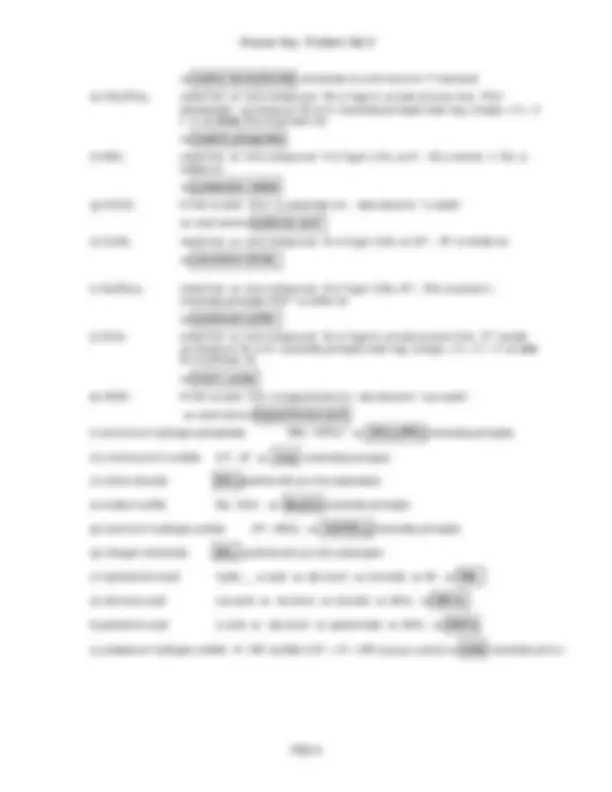




Study with the several resources on Docsity

Earn points by helping other students or get them with a premium plan


Prepare for your exams
Study with the several resources on Docsity

Earn points to download
Earn points by helping other students or get them with a premium plan
Community
Ask the community for help and clear up your study doubts
Discover the best universities in your country according to Docsity users
Free resources
Download our free guides on studying techniques, anxiety management strategies, and thesis advice from Docsity tutors
The answers and explanations for problem set 3 of a chemistry 121 course, focusing on the concepts of atomic mass, isotopes, and their natural abundances. It covers calculating atomic mass using isotopic masses and natural abundances, predicting which isotope's mass the atomic mass would be closest to, and determining the number of each type of atom and ion in a formula.
Typology: Lecture notes
1 / 4

This page cannot be seen from the preview
Don't miss anything!



% abundance of isotopes and (average) atomic mass.
Answer : No. The value of 63.546 amu is a weighted average of the two naturally occurring isotopes on Earth (Cu-63 and Cu-65; See Example 2.5). So there are only two “kinds” of Cu atoms and thus (only) two isotopic masses—one smaller than the average and one larger than it. More specifically, all of the Cu- 63 atoms have a mass less than 63.546 amu and all of the Cu- 65 atoms have a mass greater than it. But no Cu atoms have the precise mass of the weighted average.
Isotope Mass(amu) Abundance (%)
1 135.90714 0.
2 137.90599 0.
3 139.90543 88.
4 141.90924 11.
(ii) Also describe how you could predict which isotope’s isotopic mass the atomic mass would be closest to, and whether or not the atomic mass would be greater than or less than this isotope’s atomic mass, before doing the actual calculation of the atomic mass.
Answers:
(i) : 140. 1 amu; From a Periodic Table, this atomic mass matches that of cerium (symbol Ce; #58)
(ii) : Closest to isotope 3’s isotopic mass, but slightly greater than it (full answer below)
Work / Reasoning :
Let me address (ii) first. Let’s call the element X for now. One can predict that the atomic mass of X should be closest to the isotopic mass of isotope 3 because the vast majority of X atoms (over 88%) are atoms of isotope 3. Also, since the vast majority of the other atoms (in any sample of X) are of isotope 4 (11% vs less than 1 % for isotopes 1 and 2), whose isotopic mass is greater than that of isotope 3, one can predict that the atomic mass will be slightly larger than the isotopic mass of isotope 3. As such, I would predict that the atomic mass should be slightly larger than 140 amu.
To get the precise value for X’s atomic mass, multiply each isotopic mass by its fractional abundance (obtained by dividing the % abundance by 100) and sum:
(weighted average) atomic mass = 0. 0019 ( 135.90714 amu) + 0. 0025 ( 137.90599 amu) +
= 0.2 582 … + 0. 3447 .. + 123. 718 … + 15.7 94 … = 140. 115 …= 140. 1 amu
(reasonable; a bit over 140 amu, as predicted)
(c) i) Do all the individual atoms in the sample in (b) above have different masses than the atoms in the sample in (a) above? Be specific. ii) What causes fewer atoms to be in the second sample than the first?
Answers : (a) 9.568 x 10^21 atoms; (b) 9.477 x 10^21 atoms;
(c) i) No, not even most of them are different! 69.17% of the atoms in Sample 2 have identical masses to all of the atoms in Sample 1. 30.83% of the atoms in Sample 2 have a greater mass.
ii) Since some of the atoms in Sample 2 have a greater mass, it will take fewer of them to add up to a certain mass (like 1.000 g). For example, it will take fewer bowling balls to reach a mass of 16 lb (i.e., one ball!) than the number of tennis balls needed to reach 16 lb (clearly way more than 32 since a tennis ball is nowhere near even half a pound in mass).
Work / Reasoning for (a) & (b) :
Each sample has a mass of 6.022 x 10^23 amu. Each atom in (a) has a mass of 62.9396 amu. Thus, the number of atoms in the first sample (to 4 SF) is just:
9.568 x 10 atoms
21 = 9.56 7 9...x 10 = 62.9396amu/atom
6.022 x 10 amu 21 23 (all Cu-63 atoms)
Since the (average) atomic mass of Cu is 63.546 amu, the number of atoms in the “regular” sample of Cu (with both isotopes present in the ratio of their natural abundances) is just:
9.477 x 10 atoms 21 = 9.47 6 5...x 10 = 63.546amu/atom
6.022 x 10 amu 21
23 (some Cu-63 and some Cu-65)
Ions vs. Ionic Compounds, Molecular vs. Ionic Compounds
Literal “Expansion” of formula (no charges)*
(in one FU)
(in one FU)
(a) Ca(NO 2 ) 2 Ca; NO 2 ; NO 2 one Ca; two N; four O one Ca2+; two NO 2 -
(b) CuSO 4 Cu; S; O; O; O; O one Cu; one S; four O one Cu2+; one SO 42 -
(c) Al(NO 3 ) 3 Al; NO 3 ; NO 3 ; NO 3 one Al; three N; nine O one Al3+; three NO 3 -
(d) Mg(HCO 3 ) 2 Mg; HCO 3 ; HCO 3 one Mg; two H; two C; six O one Mg2+; two HCO 3 -
iodine monochloride (remember to omit mono for 1st^ element)
(e) Pb 3 (PO 4 ) 2 metal first ionic compound; Pb is Type II, so look at anion first. PO 43 -
(phosphate) charge on Pb is 2+ (neutrality principle; total neg. charge = 2 x - 3 = - 6 so three Pb's must total +6)
lead(II) phosphate
iodate ion
potassium iodate
(g) H 2 CO 3 H first acid; CO 32 -^ is carbonate ion; - ates become "-ic acids"
acid name is carbonic acid
(h) Sr 3 N 2 metal first ionic compound; Sr is Type I (2A), so Sr2+. N^3 -^ is nitride ion
strontium nitride
(i) Al 2 (SO 3 ) 3 metal first ionic compound; Al is Type I (3A), Al3+; SO 3 must be 2-;
(neutrality principle) SO 32 -^ is sulfite ion
aluminum sulfite
(j) SnO 2 metal first ionic compound; Sn is Type II, so look at anion first. O^2 -^ (oxide)
charge on Sn is 4+ (neutrality principle; total neg. charge = 2 x - 2 = - 4 so one Sn must total +4)
tin(IV) oxide
(k) HClO H first acid; ClO-^ is hypochlorite ion; - ites become "-ous acids"
acid name is hypochlorous acid
(l) ammonium hydrogen phosphate NH 4 +, HPO 42 -^ (NH 4 ) 2 HPO 4 (neutrality principle)
(m) chromium(VI) sulfide Cr^6 +, S^2 -^ CrS 3 (neutrality principle)
(n) silicon dioxide SiO 2 (prefixes tell you the subscripts)
(o) sodium sulfite Na+, SO 32 -^ Na 2 SO 3 (neutrality principle)
(p) aluminum hydrogen sulfate Al3+, HSO 4 -^ Al(HSO 4 ) 3 (neutrality principle)
(q) nitrogen trichloride NCl 3 (prefixes tell you the subscripts)
(r) hydrobromic acid hydro___ic acid - ide anion bromide Br-^ HBr
(s) bromous acid ous acid - ite anion bromite BrO 2 -^ HBrO 2
(t) perbromic acid ic acid - ate anion perbromate BrO 4 -^ HBrO 4
(u) potassium hydrogen sulfide K+, HS-^ (sulfide is S^2 -^ + H+^ = HS-^ [hydrogen sulfide]) KHS (neutrality princ.)